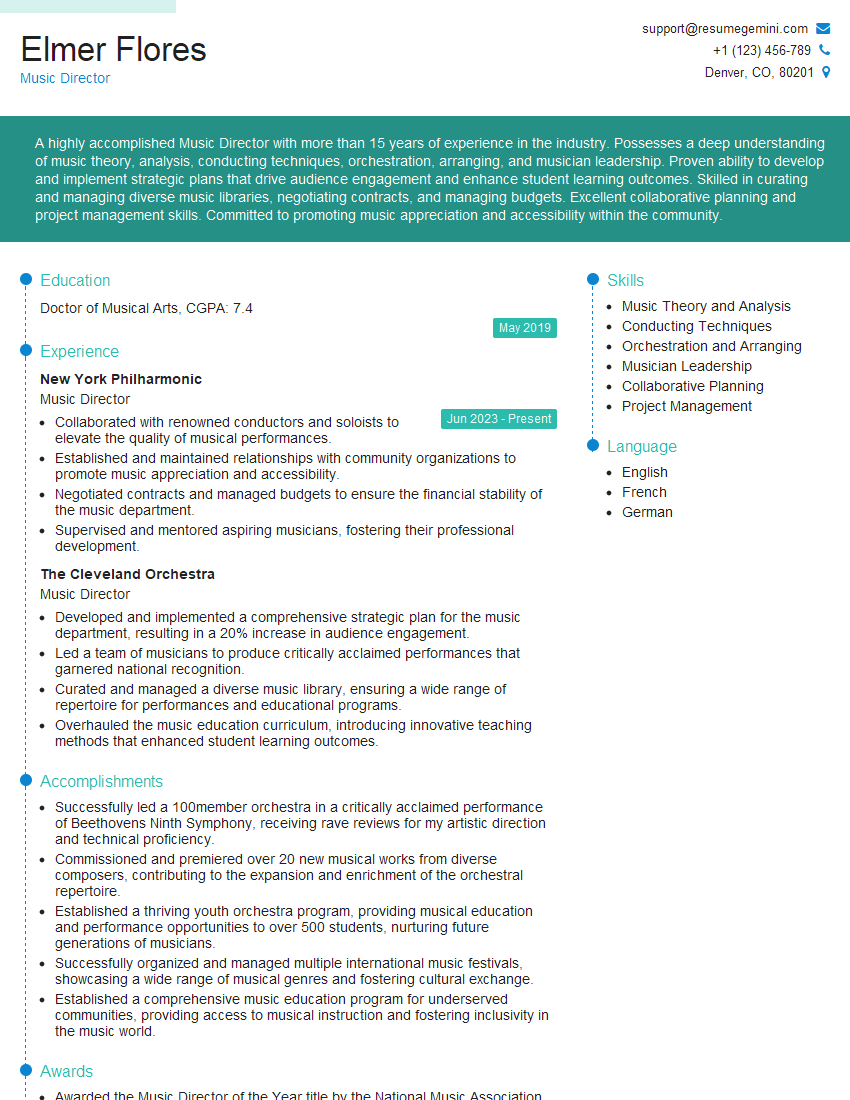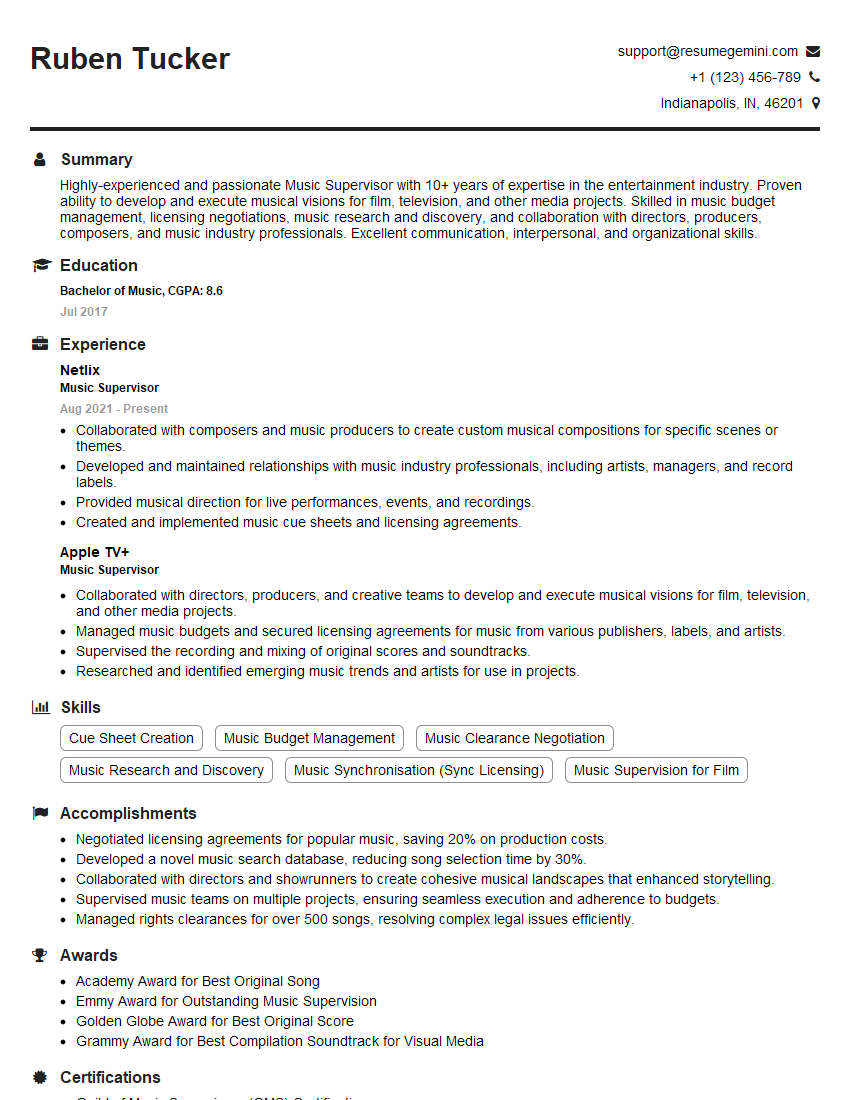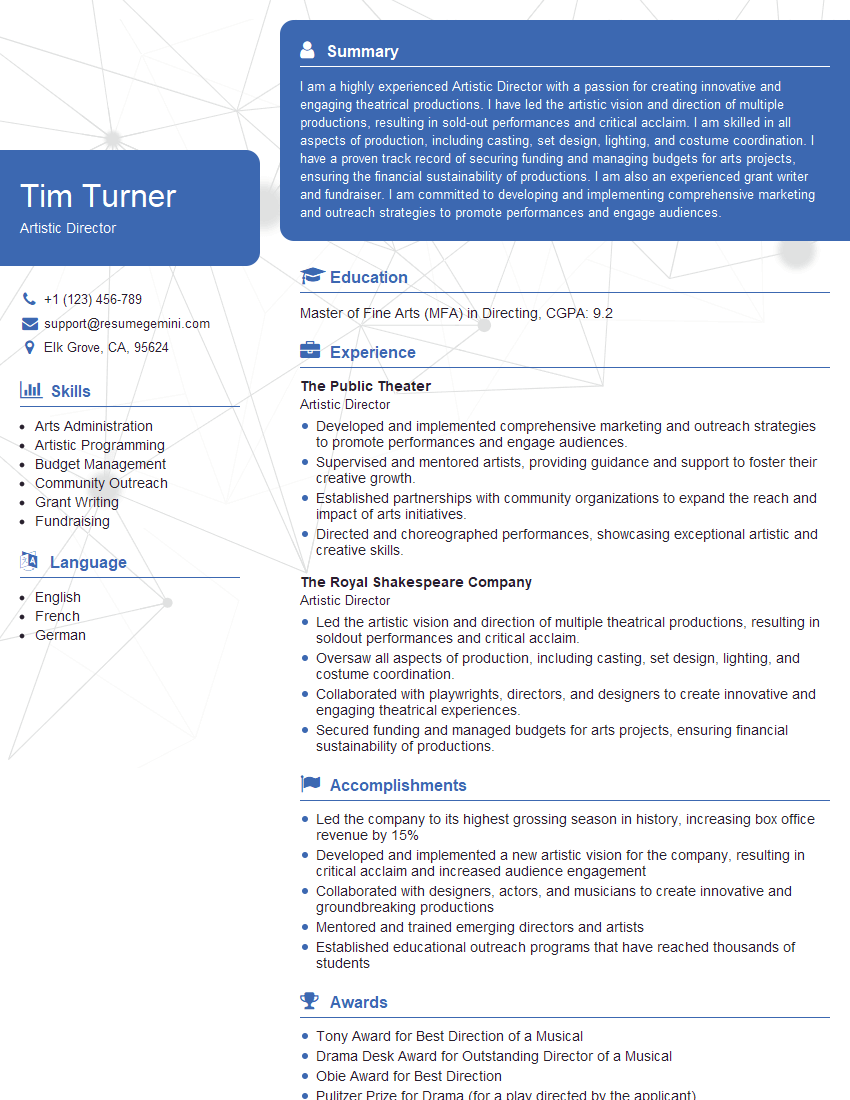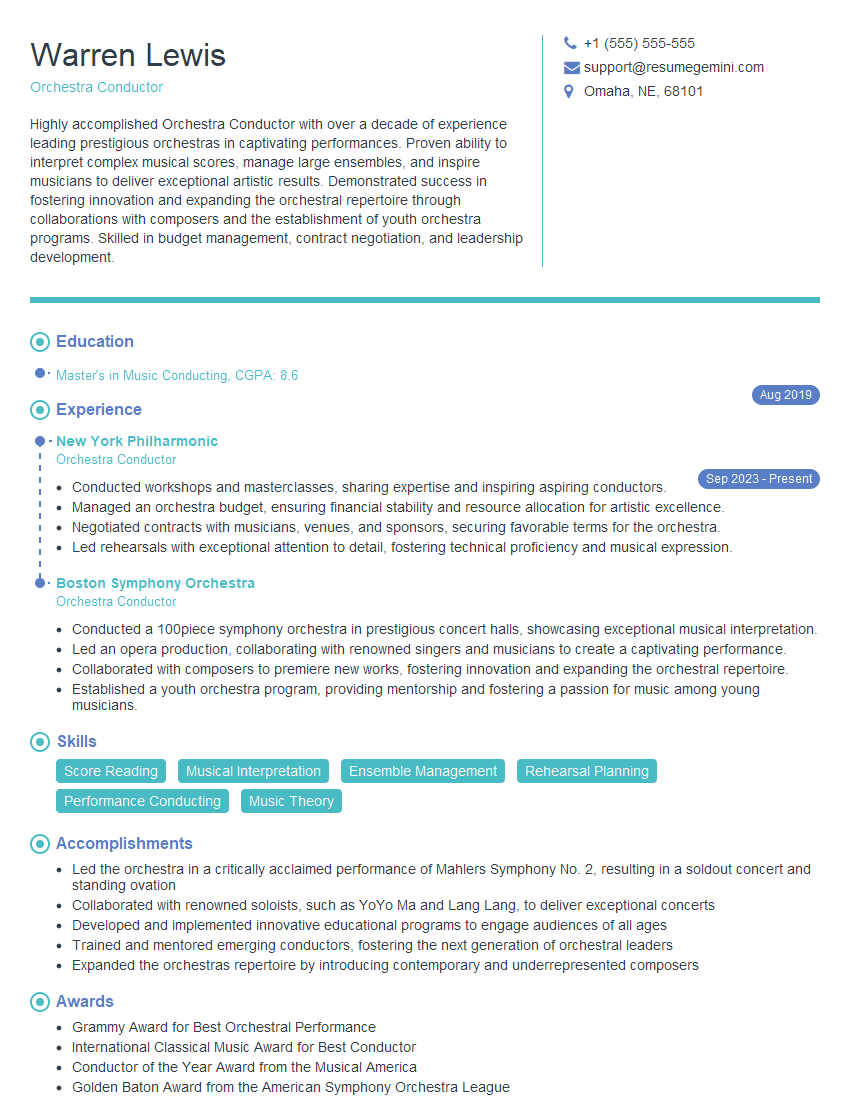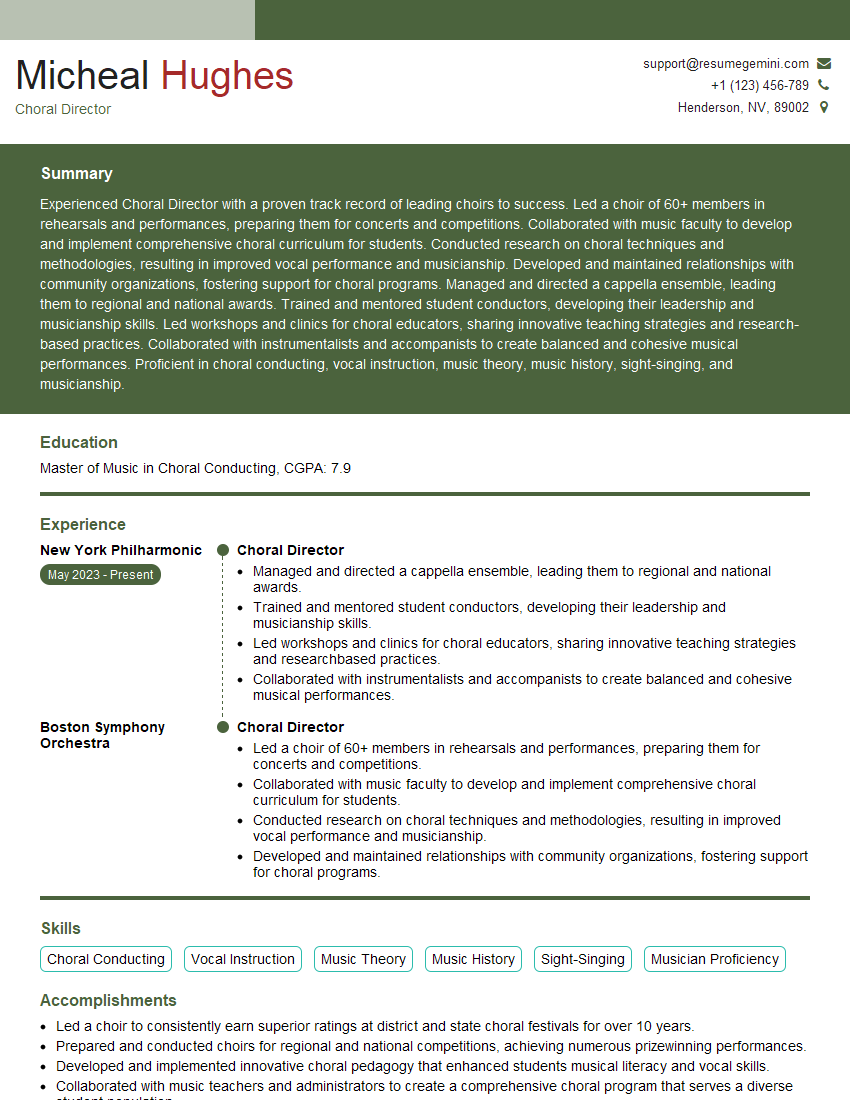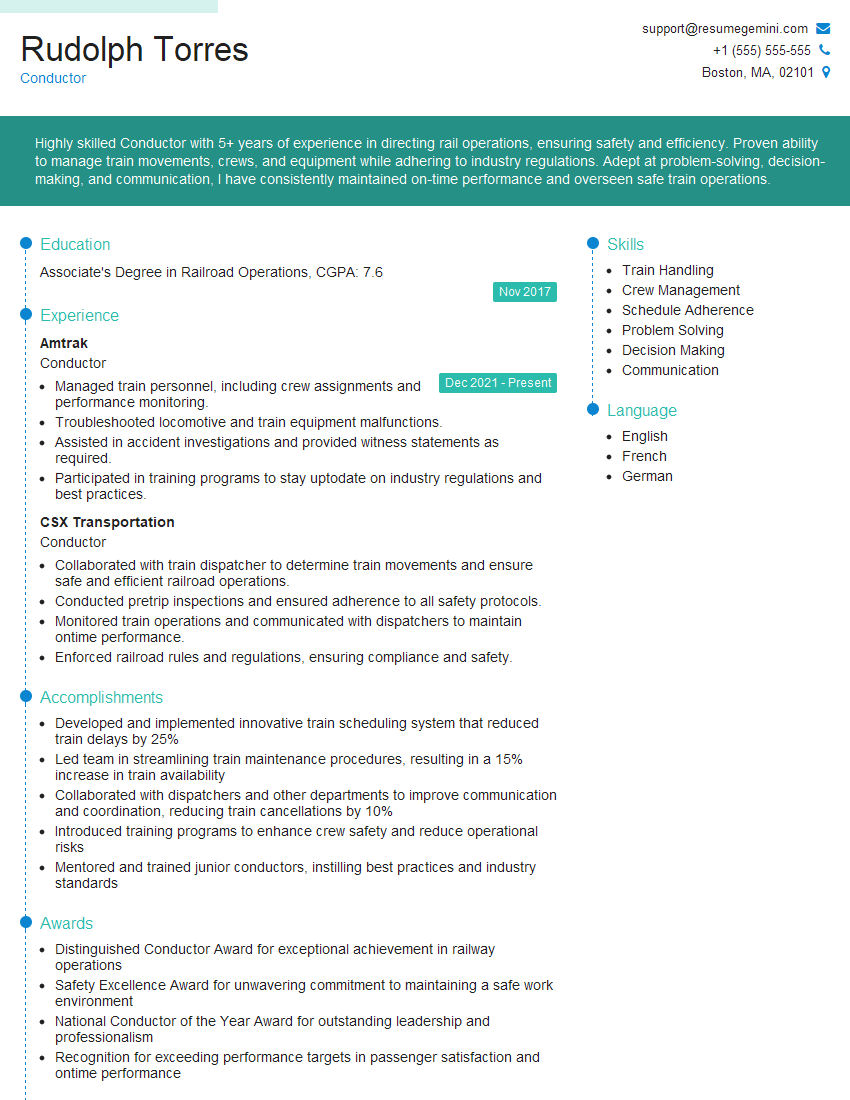Cracking a skill-specific interview, like one for Conducting and Music Direction, requires understanding the nuances of the role. In this blog, we present the questions you’re most likely to encounter, along with insights into how to answer them effectively. Let’s ensure you’re ready to make a strong impression.
Questions Asked in Conducting and Music Direction Interview
Q 1. Describe your conducting technique and philosophy.
My conducting technique is characterized by clarity, precision, and a focus on expressive communication. I believe in a balanced approach, combining clear, concise baton technique with expressive body language and nuanced phrasing. My philosophy centers around serving the music and empowering the musicians to realize its full potential. I aim to create a collaborative environment where musicians feel understood and supported, fostering their individual artistry while working towards a unified musical vision. I don’t adhere to a rigid style; rather, my technique adapts to the musical demands of the piece and the unique characteristics of the ensemble. For example, a Romantic symphony might require broader, more sweeping gestures, while a Baroque piece might necessitate a more precise, articulated style. Ultimately, my goal is to facilitate a natural, authentic performance.
Q 2. How do you prepare a score for rehearsal?
Preparing a score for rehearsal is a meticulous process that goes beyond simply marking up the music. It involves deep engagement with the work. My process starts with thorough analysis of the score, identifying formal structure, harmonic progressions, melodic lines, and rhythmic complexities. I carefully mark articulations, dynamics, phrasing, and tempo changes, using a variety of symbols and annotations to ensure clear communication with the musicians. I also meticulously study the individual instrument parts to anticipate potential challenges or technical difficulties. I’ll create rehearsal plans outlining specific sections requiring focused attention, identifying potential problem areas. For example, I might note a particularly tricky transition or a passage with complex ensemble work and create exercises to address this in advance. This proactive approach ensures smooth rehearsals and a polished final performance. I often make multiple passes through the score, refining my markings and adding further insights as my understanding of the piece deepens.
Q 3. Explain your approach to working with different instrumental sections.
Working with different instrumental sections requires understanding their unique technical capabilities, musical idioms, and performance practices. I treat each section as a distinct entity, tailoring my communication and approach accordingly. For instance, I may have to encourage the strings to focus on intonation and blend, while the brass may need precise articulation and projection control. I prioritize individual attention, taking the time to coach individual players or small groups on challenging passages. This individualized attention helps build trust and fosters a sense of shared musical responsibility within each section. It’s also crucial to highlight the importance of each section’s contribution within the larger musical texture, fostering a sense of collaborative partnership across the ensemble. Effective sectionals, followed by full ensemble rehearsals, are key to balancing individual and collective success.
Q 4. How do you manage rehearsals efficiently and effectively?
Efficient and effective rehearsals rely on meticulous planning and clear communication. Before each rehearsal, I create a detailed agenda outlining specific goals and focusing on manageable sections of the music. Time management is crucial; I set realistic targets and avoid unnecessary digressions. To keep the musicians engaged, I introduce variety to the rehearsal, alternating between sectional work, full ensemble playing, and focused work on challenging passages. Regular breaks are also essential to maintain energy levels and prevent fatigue. The environment should be positive and encouraging, allowing for a free exchange of ideas and questions. Constructive feedback is given frequently, and progress is celebrated, ensuring everyone feels valued and motivated throughout the rehearsal process.
Q 5. How do you communicate effectively with musicians?
Effective communication with musicians is paramount. I strive to create an open and respectful dialogue, encouraging them to express their questions and concerns freely. Clear and precise language is essential, and I avoid ambiguity in my instructions. I also utilize nonverbal cues, including body language and expressive facial expressions, to reinforce musical intentions. Active listening is also critical; I actively pay attention to the musicians’ input, considering their ideas and suggestions. Building strong relationships with the musicians based on mutual respect and trust forms the foundation of effective communication. Regular informal chats help build rapport and allows for a more relaxed atmosphere during rehearsals.
Q 6. How do you address performance issues during rehearsals?
Addressing performance issues requires a balanced approach combining constructive criticism with positive reinforcement. When issues arise, I begin by identifying the specific problem. This could involve anything from intonation problems to rhythmic inaccuracies or balance issues. I then collaborate with the musicians to diagnose the root cause of the problem, offering clear, targeted feedback. This often involves breaking down complex passages into smaller, more manageable segments. Demonstrations on the piano or through individual coaching can be effective ways to illustrate specific points. I emphasize solutions rather than focusing solely on the problems, keeping the rehearsal environment positive and encouraging. Celebrating successes, no matter how small, keeps motivation high and fosters a collaborative spirit.
Q 7. Describe your experience working with diverse musical styles.
My experience encompasses a wide range of musical styles, from Baroque and Classical to Romantic, Impressionistic, and contemporary works. This versatility has allowed me to develop a flexible and adaptable approach to conducting. I’ve conducted orchestras, chamber ensembles, and choirs, working on diverse repertoire, including orchestral masterworks, chamber music, opera, and musical theatre scores. Each style presents its own unique challenges and opportunities. My approach always centers on immersing myself in the musical idiom, studying the historical context, and understanding the stylistic conventions to ensure an authentic and engaging performance. For example, conducting a Bach cantata requires a different approach than conducting a Mahler symphony, demanding specific technical and interpretative skills particular to each genre.
Q 8. How do you balance artistic vision with the practical constraints of a performance?
Balancing artistic vision with practical constraints is a constant negotiation in conducting. It’s like sculpting a magnificent statue, knowing you have limitations in the size of the marble block and the tools at your disposal. The ideal is rarely achievable without compromise.
My approach begins with a deep understanding of the score – its inherent musicality and the composer’s intentions. This informs my artistic vision, setting the parameters for the overall interpretation. Then, I assess the practicalities: the venue’s acoustics, the orchestra’s capabilities, the available rehearsal time, and even the budget. Sometimes, I might have to modify a dynamic marking slightly to avoid overwhelming the hall’s acoustics, or simplify a complex passage if the orchestra lacks the necessary technical proficiency. The key is to find creative solutions that honor the spirit of the music without sacrificing its integrity.
For example, when conducting Mahler’s Symphony No. 2, I might need to adjust the tempo slightly in certain sections to accommodate the capabilities of a specific choir and orchestra without compromising the grandeur and emotional impact of the piece. The essence of the piece remains, yet it is finely tuned to its performance conditions.
Q 9. How do you handle disagreements with musicians or other members of the artistic team?
Disagreements are inevitable in collaborative artistic endeavors. Instead of viewing them as conflicts, I see them as opportunities for growth and richer interpretations. My approach emphasizes open communication and respect. I always listen actively to understand the musician’s perspective, even if I don’t agree with it initially.
I encourage a collaborative dialogue, seeking a compromise that balances individual artistic viewpoints with the overall artistic vision. Sometimes, I might demonstrate a different approach technically, and other times, I might explain the rationale behind my interpretation. I believe in transparency; if a decision is made that might seem arbitrary, I always explain the reasoning behind it. I avoid imposing my will, instead aiming to build consensus through persuasion and shared understanding. It’s crucial to ensure that everyone feels heard and valued, so the rehearsal process remains positive and creative.
For instance, if a violinist expresses concerns about a particular passage being technically challenging, I will work with them to explore alternative bowings or fingerings to overcome the difficulty, instead of insisting they play it exactly as written if it would result in a poor performance.
Q 10. Describe your experience with score study and analysis.
Score study and analysis are foundational to my work. It’s more than just reading the notes; it’s delving into the composer’s mind. My process involves several stages: a preliminary reading to grasp the overall structure and form, followed by a detailed analysis of individual phrases and sections, exploring melodic contours, harmonic progressions, and rhythmic intricacies. I also research the historical context, the composer’s life, and any available performance notes or letters to understand the intended emotional weight and nuances of the music. This deeper understanding helps me to craft a nuanced and informed interpretation.
I use analytical tools such as identifying leitmotifs, analyzing thematic transformations, and understanding the formal structure (sonata form, rondo, etc.). Furthermore, I often compare different editions of the score to understand potential variations in interpretation and note any editorial choices. The goal is to develop a complete comprehension of the work before ever setting foot in a rehearsal room.
For example, when preparing a performance of Beethoven’s 5th Symphony, I thoroughly study the development section’s complex thematic transformations, tracing how the primary motif is fragmented, developed, and recombined to create dramatic tension. This deep dive allows for a richer interpretation that goes beyond mere note-playing.
Q 11. Explain your process for selecting repertoire.
Selecting repertoire involves several factors. First, there is the consideration of the orchestra’s capabilities and the available resources. Selecting a piece that is overly demanding for a less experienced ensemble wouldn’t lead to a successful performance. Secondly, I examine audience expectations and programmatically balance the performance for flow and appeal. A balance of familiar works and lesser-known pieces that complement each other often works best. Finally, I consider the emotional arc of the overall program and choose pieces that narratively connect. For me, the repertoire selection should feel like a carefully curated journey, offering a diverse yet unified musical experience.
Programmatically, I often think of creating an arc to the concert. Perhaps starting with a lighter, more accessible piece to establish a good mood, then progressing to a more emotionally challenging work, and finally concluding with a piece that leaves the audience uplifted and satisfied. The balance and flow of a concert program are equally as important as the musical quality of individual pieces.
For instance, pairing a vibrant, dance-like work by Stravinsky with a more introspective piece by Debussy can provide a varied and enriching experience for the listener, thereby creating a more engaging concert.
Q 12. How do you engage and motivate musicians during rehearsals and performances?
Engaging and motivating musicians is crucial for successful rehearsals and performances. It starts with establishing a positive and collaborative atmosphere where everyone feels respected and valued. I aim to foster a sense of shared purpose and artistic vision. Clear communication is key, ensuring that everyone understands my interpretations and expectations.
I believe in using positive reinforcement, praising both individual and collective achievements. I also provide constructive feedback, focusing on solutions rather than criticism. I always encourage questions and facilitate open dialogue, acknowledging that musicians have valuable insights and contributions. I also try to incorporate some elements of fun and creative exploration into the rehearsal process to keep the atmosphere light and energetic. A sense of shared excitement and discovery is invaluable to collaborative artistic work.
For example, during a rehearsal, if a section struggles with a particularly tricky passage, I might break it down into smaller segments, providing individualized attention and guidance. Then, we’ll put the whole section back together, celebrating the improved performance together.
Q 13. How do you incorporate audience engagement into your performances?
Audience engagement goes beyond just playing the music well; it’s about creating a shared experience. This involves various techniques, depending on the context and the nature of the music itself. Pre-concert talks are an excellent way to build anticipation and context. During the performance, I might use subtle gestures to emphasize a poignant moment or connect with the audience visually to establish a rapport. The way a piece is introduced, through a short explanatory comment before the start of the performance, helps engage the audience.
For more interactive experiences, I might incorporate visual projections or multimedia elements, particularly with contemporary works. Sometimes, a simple acknowledging glance or a warm smile toward the audience can go a long way in creating a meaningful connection. The goal is to invite the audience into the musical world, making them feel like active participants in the performance, rather than passive observers.
For example, when performing a piece with a strong narrative element, I might use dramatic pauses and expressive gestures to enhance the storytelling aspect of the music, engaging the audience on an emotional level.
Q 14. What are your strengths and weaknesses as a conductor?
My strengths lie in my ability to articulate a clear artistic vision and effectively communicate it to musicians. I am also adept at creating a collaborative and supportive rehearsal environment. I am known for my meticulous score preparation and my ability to bring out the best in musicians. I also possess strong communication skills, effectively connecting with both musicians and audiences.
However, I am always working on improving my ability to manage time constraints more efficiently during rehearsals. While I appreciate detailed work, sometimes it’s a balance between detail and overall performance. I’m also aware that developing greater flexibility in my approach to various musical styles is a constant area for improvement. It’s a continuous learning process, and I actively seek feedback to address my weaknesses and refine my conducting skills constantly.
Q 15. How do you adapt your conducting style to different ensemble sizes and acoustics?
Adapting my conducting style to different ensemble sizes and acoustics is crucial for achieving a balanced and resonant sound. With smaller ensembles, my gestures become more nuanced and precise, focusing on individual phrasing and articulation. A larger orchestra requires broader, more expansive movements to encompass the entire group, ensuring clarity and unity. Acoustics play a vital role; a reverberant hall demands a slightly more restrained approach, to avoid muddiness. Conversely, a dry space might require slightly more energetic conducting to ensure sufficient projection and warmth. For example, conducting a string quartet in a small chamber requires subtle cues and attentive listening to balance each instrument’s tone. In contrast, conducting a symphony orchestra in a large concert hall necessitates bolder gestures that carry across the expansive space. I often adjust my baton technique, using a lighter touch in smaller venues to avoid overwhelming the delicate balance, while employing fuller strokes in larger halls to project my intentions to the entire ensemble.
Career Expert Tips:
- Ace those interviews! Prepare effectively by reviewing the Top 50 Most Common Interview Questions on ResumeGemini.
- Navigate your job search with confidence! Explore a wide range of Career Tips on ResumeGemini. Learn about common challenges and recommendations to overcome them.
- Craft the perfect resume! Master the Art of Resume Writing with ResumeGemini’s guide. Showcase your unique qualifications and achievements effectively.
- Don’t miss out on holiday savings! Build your dream resume with ResumeGemini’s ATS optimized templates.
Q 16. Describe your experience working with a composer or arranger.
I’ve had the pleasure of collaborating with several composers and arrangers. One particularly memorable experience was working with a contemporary composer on the premiere of his new orchestral work. During the rehearsal process, we engaged in close dialogue about his intentions for the piece. He was interested in exploring unusual instrumental techniques, pushing the boundaries of traditional orchestration. This required me to not only understand his musical vision but also to translate that vision effectively to the orchestra. We worked closely together to refine the details, experimenting with different instrumental combinations and articulations until we achieved the desired effect. This iterative process of feedback and refinement is essential for bringing a new work to life, and building a collaborative relationship with the composer is fundamental to a successful outcome. For example, he had initially written a passage for the violins that sounded too thin, we explored alternate bowing techniques and dynamics, ultimately enhancing the overall texture.
Q 17. How do you deal with unexpected technical or musical challenges during a performance?
Unexpected challenges during a performance are inevitable. My approach involves a combination of preparation, quick thinking, and adaptability. Thorough rehearsal is essential to minimize unexpected issues, but a flexible mindset is vital. If a musician misses an entrance, for example, I might subtly adjust the tempo or use eye contact to guide them back into the flow. If a technical problem arises, such as a malfunctioning instrument, I work quickly with stagehands to resolve the issue, or if necessary, adjust the performance to accommodate the limitation. A calm and decisive demeanor is crucial to maintain the ensemble’s focus and confidence. For example, during a performance of Mahler’s Symphony No. 5, a horn player’s instrument went out of tune. I immediately communicated with the player using a nonverbal cue, silently signaling them to stop playing until the problem was rectified. The interruption was minimal, and the performance continued seamlessly. This involves quick problem-solving and subtle communication to mitigate the impact of any unexpected event.
Q 18. How do you manage the tempo and dynamics of a musical piece effectively?
Managing tempo and dynamics requires a sensitive and nuanced approach. It’s not simply about following the metronome marking; it’s about shaping the musical narrative through subtle shifts in tempo and dynamic variations. I build the tempo organically, allowing it to breathe and respond to the emotional arc of the music. Dynamic control is equally important, creating contrast and highlighting key moments. For example, a gradual crescendo can build tension towards a climax, while a sudden diminuendo can create a feeling of surprise or quiet reflection. I often employ different techniques such as rubato (flexible tempo) and phrasing to enhance the expressiveness of the music, making use of non-verbal cues to guide the ensemble. My approach is not prescriptive, allowing for creative interpretation, but always maintaining structural integrity and clarity. It’s about creating a fluid, expressive performance rather than a rigid adherence to printed markings.
Q 19. How do you balance the individual contributions of musicians while maintaining a cohesive ensemble sound?
Balancing individual contributions while maintaining ensemble unity is a delicate art. It involves fostering a collaborative environment where each musician feels valued and empowered. During rehearsals, I listen attentively to each section, providing individual feedback and encouragement. I aim to create a sense of shared responsibility, where every musician understands their role in creating the overall sound. Techniques such as section balances and careful listening during rehearsals are vital. I use clear and concise instructions, ensuring everyone is on the same page. Creating a strong sense of community within the ensemble can contribute significantly to a cohesive sound. Building trust and respect amongst the musicians is key to this process. I treat every member of the ensemble with respect and equality, regardless of their instrument or skill level. A successful performance is a collective achievement, not a solo effort.
Q 20. What is your experience with conducting choral music?
I have extensive experience conducting choral music, working with choirs ranging in size from small chamber ensembles to large symphonic choruses. My approach is always sensitive to the specific vocal textures and capabilities of the choir. I focus on clear diction, precise intonation, and dynamic nuance. I pay particular attention to blending the vocal parts, ensuring that each section contributes equally to the overall balance. Choral conducting requires a deeper understanding of vocal technique and a collaborative approach to achieve a unified sound. Working with choirs often involves careful consideration of breath control, vowel formation, and the management of different vocal timbres, in addition to the standard musical elements.
Q 21. Describe your familiarity with different conducting patterns and techniques.
My familiarity with conducting patterns and techniques is broad, encompassing various styles and approaches. I am proficient in the Italian, German, and French schools of conducting, each with its distinct characteristics. The Italian style emphasizes expressive freedom and expansive gestures, while the German school favors precision and clarity. The French style often combines aspects of both. Beyond these broad categories, I’ve studied various techniques for conducting different instrumental families and vocal ensembles. My approach is not to rigidly adhere to a single style but to adapt and modify my technique based on the specific requirements of the music and the ensemble. For example, conducting a Romantic-era symphony might require broader gestures, whilst conducting Baroque music may call for a more precise and understated approach. This versatility allows me to elicit the most effective response from diverse musical groups.
Q 22. How do you use your body language to communicate musical ideas effectively?
Effective communication as a conductor transcends mere verbal instruction; body language is paramount. Think of it as a silent conversation supplementing your spoken cues. My approach utilizes a range of non-verbal cues to convey musical ideas precisely and expressively.
Posture and Gesture: My posture reflects the music’s character. A broad, open stance might convey grandeur, while a more intimate, contained posture might suggest introspection. Gestures are crucial – a subtle hand movement might indicate a delicate phrasing, while a larger, more decisive gesture might signal a dramatic crescendo.
Facial Expressions: My facial expressions mirror the emotional landscape of the music. A joyful passage is reflected in a smile, a melancholic passage in a thoughtful expression. These subtle nuances are critical to guiding the emotional interpretation of the musicians.
Eye Contact: I use eye contact to connect with individual musicians and sections, providing individualized feedback and encouragement. It allows me to assess their understanding and adjust my approach accordingly. A direct gaze during a critical moment can be incredibly powerful.
Conducting Technique: My conducting technique itself is a form of body language. Precise, clear baton movements dictate tempo, dynamics, and articulation, communicating rhythmic and melodic details with clarity and precision. The slightest change in the angle or weight of the baton can make a significant difference in the interpretation.
For example, when working on a particularly nuanced passage in a Mahler symphony, I might use a combination of subtle head movements, gentle hand gestures, and focused eye contact to guide the orchestra towards a specific phrasing and dynamic contour. The goal is always clarity and consistent communication with the ensemble.
Q 23. How do you create a positive and productive rehearsal environment?
Creating a positive and productive rehearsal environment is key to success. It’s about fostering a collaborative spirit where musicians feel safe to take risks, experiment, and learn. My approach emphasizes respect, clear communication, and a focus on mutual growth.
Establish Clear Expectations: Rehearsals begin with clearly stated goals and objectives. Musicians need to understand what we are aiming to achieve in each session.
Constructive Feedback: I offer feedback that is both specific and encouraging, focusing on solutions rather than simply pointing out errors. I always emphasize the positive aspects of the performance and use examples to illustrate areas for improvement.
Active Listening: I listen attentively to the musicians, acknowledging their contributions and valuing their input. A collaborative environment is essential.
Flexibility and Adaptability: I recognize that rehearsals don’t always go according to plan. I am flexible and ready to adjust my approach based on the ensemble’s needs and progress. Sometimes, a spontaneous break or a change in approach can reinvigorate the rehearsal.
Positive Reinforcement: I regularly praise and celebrate the achievements of the musicians, fostering a sense of accomplishment and boosting morale. Positive reinforcement is extremely motivating.
For instance, during a particularly challenging section, instead of simply correcting mistakes, I might break down the passage into smaller, more manageable sections, offering individualized coaching and praising even small improvements. This approach creates a supportive learning environment, where musicians feel empowered and motivated.
Q 24. Describe your experience in program planning and development.
Program planning and development are crucial aspects of my work. It’s a process of thoughtful curation and strategic vision, balancing artistic ambition with practical considerations.
Artistic Vision: I start with a clear artistic vision for each program. This might involve exploring a specific composer, a thematic focus, or a combination of works that create a cohesive and engaging experience for the audience.
Audience Engagement: I consider the target audience when selecting works, considering factors such as their musical experience and preferences. Program notes and pre-concert talks are integral parts of audience engagement.
Practical Considerations: I must consider practical constraints such as budget, available musicians, venue limitations, and rehearsal time. This requires careful planning and negotiation.
Balance and Variety: I strive to create programs that offer a balance between familiar works and lesser-known pieces, showcasing variety in style, instrumentation, and emotional range.
Collaboration: Program development is often a collaborative effort. I work closely with management, musicians, and potentially other stakeholders, such as marketing and PR teams.
For example, I recently developed a program centered around the theme of ‘Nature in Music,’ featuring works by Debussy, Vaughan Williams, and lesser-known contemporary composers. This involved researching appropriate works, selecting arrangements, and coordinating with the musicians to ensure the program was both artistically fulfilling and practically feasible.
Q 25. What are your long-term goals as a conductor?
My long-term goals as a conductor encompass artistic growth, leadership development, and a dedication to fostering musical excellence. I aim to continue expanding my repertoire and honing my interpretive skills, leading diverse ensembles, and contributing to the musical landscape through innovative programming and educational initiatives.
Artistic Exploration: I aspire to conduct a wider range of orchestral and choral works, exploring different periods and styles of music, and deepening my understanding of compositional techniques.
Mentorship and Leadership: I aim to mentor and inspire the next generation of musicians through workshops, masterclasses, and fostering a collaborative and supportive environment.
Community Engagement: I envision broadening my role in community engagement by conducting educational concerts, outreach programs, and workshops designed to make classical music accessible to a wider audience.
International Collaboration: I am keen to expand my collaborations to include international orchestras and ensembles, fostering cross-cultural exchanges and enriching my own musical understanding.
Ultimately, my goal is to leave a lasting impact on the world of music, not only through my conducting but also by empowering other musicians and inspiring a love of music in audiences across the globe.
Q 26. How do you stay current with developments in the musical world?
Staying current in the musical world is a continuous process. I utilize a multi-faceted approach to ensure I remain informed about the latest developments and trends.
Attending Concerts and Performances: I regularly attend concerts and performances by leading orchestras and ensembles worldwide. This offers first-hand experience of current interpretations and innovative approaches.
Listening to Recordings: I actively listen to new recordings and explore a diverse range of musical styles, keeping abreast of emerging composers and innovative performances.
Reading Musical Literature: I regularly read scholarly articles, journals, and books on music history, theory, and analysis, deepening my understanding of musical contexts and trends.
Networking with Musicians and Scholars: I maintain a network of colleagues, fellow conductors, composers, and musicologists, engaging in discussions and exchanging ideas.
Following Online Resources: I follow relevant websites, blogs, and social media platforms that provide up-to-date information on the music world, ensuring I’m connected to the latest news and discussions.
For instance, I recently attended a conference on contemporary music which broadened my understanding of current compositional trends, introducing me to several innovative composers whose works I am now actively exploring.
Q 27. Describe your familiarity with different musical notation systems.
I am proficient in various musical notation systems, understanding their nuances and historical contexts. This proficiency is essential for interpreting scores accurately and efficiently.
Standard Western Notation: This is my primary system, encompassing traditional staff notation, including clefs, key signatures, time signatures, and rhythmic notation.
Tablature (Guitar, Lute, etc.): I’m familiar with tablature, particularly for guitar and lute music, understanding how it represents notes and fingering.
Historical Notation Systems: I have a working knowledge of historical notation systems, including those used in Renaissance and Baroque music, recognizing the differences in notation conventions over time.
Computer-Based Notation Software: I am experienced using music notation software such as Sibelius and Finale, proficient in creating and editing scores digitally.
My ability to read and interpret various notation systems allows me to work effectively with diverse musical styles and historical periods. Understanding the historical context of the notation often informs my interpretive decisions, leading to a more nuanced and authentic performance.
Q 28. How do you prioritize your tasks and manage your time effectively?
Effective time management and task prioritization are critical for a conductor. My approach is based on a combination of planning, organization, and mindful delegation.
Detailed Planning: I create detailed schedules for rehearsals, performances, and administrative tasks, allocating specific time slots for each activity.
Prioritization Matrix: I use a prioritization matrix (like the Eisenhower Matrix) to categorize tasks based on urgency and importance, ensuring that crucial tasks receive the necessary attention.
Time Blocking: I allocate specific time blocks for focused work on different tasks, minimizing distractions and maximizing productivity.
Delegation: I delegate appropriate tasks to others where possible, such as administrative responsibilities or logistical planning, freeing up time for my core conducting activities.
Regular Review and Adjustment: I regularly review my schedule and adjust priorities as needed, acknowledging that unforeseen circumstances can arise and require adaptation.
For instance, during the preparation for a major concert series, I meticulously plan rehearsals, allocating specific time for sectional rehearsals, full orchestral rehearsals, and individual coaching sessions. This detailed planning, along with strategic prioritization of tasks, ensures efficient use of my time and maximizes the effectiveness of rehearsals.
Key Topics to Learn for Conducting and Music Direction Interview
- Score Study & Analysis: Understanding phrasing, dynamics, articulation markings, and composer’s intent; applying this knowledge to shape a musical interpretation.
- Rehearsal Techniques: Effective communication with musicians, providing clear and concise instructions; addressing technical and musical challenges; fostering a collaborative rehearsal environment.
- Conducting Technique: Mastering baton technique, precise cues, and clear communication of tempo, dynamics, and expression; adapting technique to various ensemble sizes and styles.
- Musical Styles & Periods: Demonstrating a comprehensive understanding of diverse musical genres and historical periods; applying stylistic authenticity in your interpretations.
- Program Building & Curating: Developing cohesive and engaging concert programs; considering audience engagement, thematic unity, and artistic vision.
- Collaboration & Communication: Working effectively with musicians, singers, stage managers, and other artistic personnel; articulating your artistic vision clearly and persuasively.
- Problem-Solving & Adaptability: Addressing unexpected challenges during rehearsals and performances; maintaining composure and finding creative solutions.
- Score Preparation & Editing: Familiarity with music notation software; ability to prepare scores for rehearsal and performance; making informed editorial decisions.
Next Steps
Mastering Conducting and Music Direction opens doors to fulfilling careers in orchestras, opera houses, theaters, and educational institutions. A strong resume is crucial for showcasing your skills and experience to potential employers. Building an ATS-friendly resume is essential to ensure your application gets noticed by Applicant Tracking Systems. To create a compelling resume that highlights your unique talents and experience, we strongly recommend using ResumeGemini. ResumeGemini provides a user-friendly platform and offers examples of resumes tailored to Conducting and Music Direction to help you craft a professional and impactful document that secures you the interviews you deserve.
Explore more articles
Users Rating of Our Blogs
Share Your Experience
We value your feedback! Please rate our content and share your thoughts (optional).
What Readers Say About Our Blog
Hello,
We found issues with your domain’s email setup that may be sending your messages to spam or blocking them completely. InboxShield Mini shows you how to fix it in minutes — no tech skills required.
Scan your domain now for details: https://inboxshield-mini.com/
— Adam @ InboxShield Mini
Reply STOP to unsubscribe
Hi, are you owner of interviewgemini.com? What if I told you I could help you find extra time in your schedule, reconnect with leads you didn’t even realize you missed, and bring in more “I want to work with you” conversations, without increasing your ad spend or hiring a full-time employee?
All with a flexible, budget-friendly service that could easily pay for itself. Sounds good?
Would it be nice to jump on a quick 10-minute call so I can show you exactly how we make this work?
Best,
Hapei
Marketing Director
Hey, I know you’re the owner of interviewgemini.com. I’ll be quick.
Fundraising for your business is tough and time-consuming. We make it easier by guaranteeing two private investor meetings each month, for six months. No demos, no pitch events – just direct introductions to active investors matched to your startup.
If youR17;re raising, this could help you build real momentum. Want me to send more info?
Hi, I represent an SEO company that specialises in getting you AI citations and higher rankings on Google. I’d like to offer you a 100% free SEO audit for your website. Would you be interested?
Hi, I represent an SEO company that specialises in getting you AI citations and higher rankings on Google. I’d like to offer you a 100% free SEO audit for your website. Would you be interested?
good
